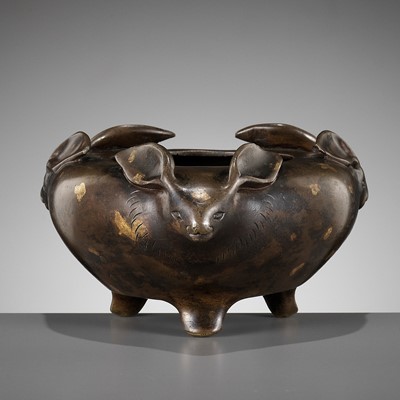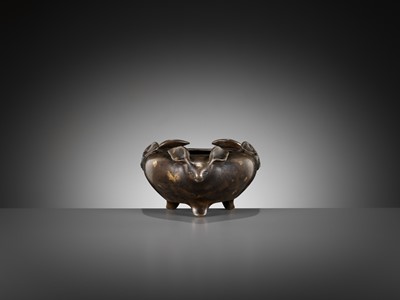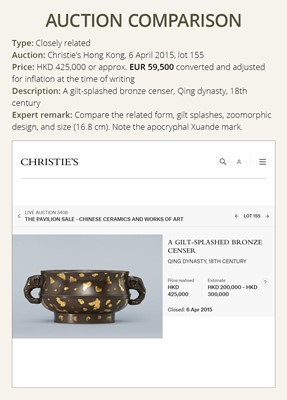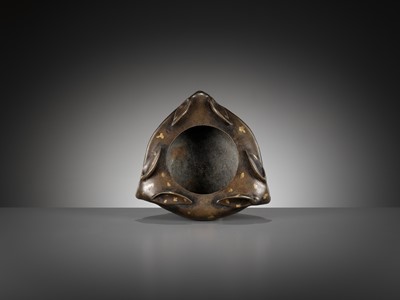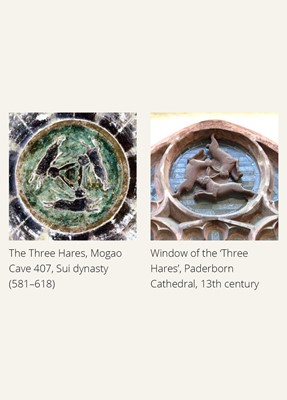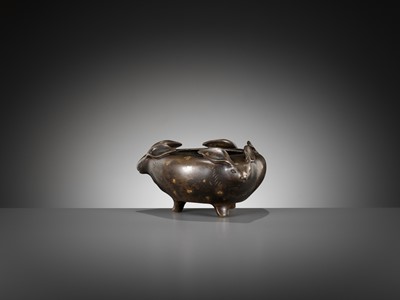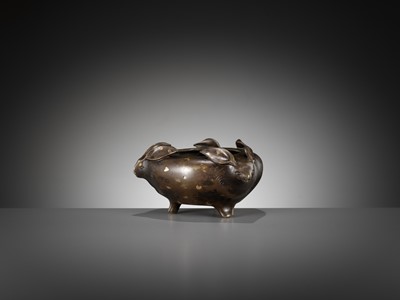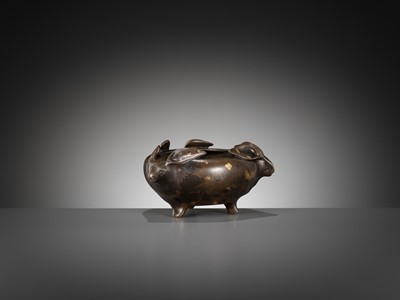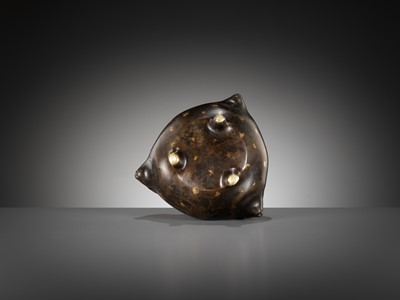2nd Jun, 2023 11:00
Fine Chinese Art / 中國藝術集珍 / Buddhism & Hinduism
139
A RARE GILT-SPLASHED BRONZE ‘THREE HARES’ CENSER, 17TH-18TH CENTURY
十七至十八世紀罕見灑金三兔爐
Sold for €3,380
including Buyer's Premium
China. Heavily cast, supported on three short feet, of compressed globular form with three hare’s heads, each flanked with two long ears and neatly incised with almond shaped eyes, a curling mouth, and fur framing the neck, the exterior finely embellished with irregular gilt splashes.
Provenance: Wiltshire, United Kingdom, local trade. By repute acquired from a private estate.
Condition: Good condition with old wear and casting flaws as expected, remnants of ancient varnish, few small nicks and dents, light scratches. An old circular fill to the top side, probably inherent to manufacture. Naturally grown patina overall.
Weight: 1,044 g
Dimensions: Length 16.7 cm
The three hares is a circular motif appearing in sacred sites in East Asia, the Middle East, and Europe. It has been used as an architectural ornament, a religious symbol, and in modern works of art. The three hares first appear in the Mogao Caves in Dunhuang, but over the centuries the iconography slowly spread towards the West. They next appear on early 13th-century Mongol metalwork, and on a copper coin, found in Iran, dated to 1281. Then they are found again on a 14th-century box, later used as a reliquary, made in Iran under Mongol rule, and now preserved in the treasury of the Cathedral of Trier in Germany. On its base, the casket has Islamic designs, and originally featured two images of the three hares, one later lost through damage. Thereafter, it eventually occurs with the greatest frequency in the churches of Devon, England, where it appears to be a recollection of earlier Insular design, such as the Romano-British designs which are known from Celtic (La Tène) metalwork. The main theory pertaining to the dissemination of the motif is that it was transported from China across Asia and as far as the southwest of England via designs found on expensive Oriental ceramics by merchants traveling the Silk Road. According to researchers, the ‘three hares’ is an auspicious symbol that represents peace and tranquility.
Auction result comparison:
Type: Closely related
Auction: Christie’s Hong Kong, 6 April 2015, lot 155
Price: HKD 425,000 or approx. EUR 59,500 converted and adjusted for inflation at the time of writing
Description: A gilt-splashed bronze censer, Qing dynasty, 18th century
Expert remark: Compare the related form, gilt splashes, zoomorphic design, and size (16.8 cm). Note the apocryphal Xuande mark.
十七至十八世紀罕見灑金三兔爐
中國。三足爐,球形,三個兔首,每個側面有兩只長耳朵,杏仁形眼睛,捲曲的嘴巴,頸部毛皮細膩刻畫,外壁不規則灑金。
來源:英國威爾特郡古玩交易,據説購於一個私人收藏。
品相:狀況良好,有磨損和鑄造缺陷,老漆的殘留物,少量小刻痕和凹痕,輕微劃痕。頂部的圓形填充物,可能是製造過程中固有的。整體自然生長的包漿。
重量:1,044 克
尺寸:長16.7 厘米
三隻兔的圖案出現在東亞、中東和歐洲聖地。它多被用作建築裝飾、宗教標誌和現代藝術作品。三隻兔圖案最早出現在敦煌莫高窟,但幾個世紀以來,圖像逐漸向西方傳播,之後於十三世紀早期出現在蒙古金屬製品上以及在伊朗發現的一枚銅幣上,日期為 1281 年。然後它們再次出現在一個十四世紀的盒子上,後來用作聖物箱,在蒙古統治下的伊朗製造,現在保存在德國特里爾大教堂的寶庫中。另外,這個圖案非常頻繁地出現在英格蘭德文郡的教堂中,在那裡它似乎是對早期島嶼設計的回憶,例如凱爾特人金屬製品中的羅馬-英國設計。 關於圖案傳播的主要理論是,它是通過絲綢之路上的商人在昂貴的東方陶瓷上的發現,從中國運到亞洲並遠至英格蘭西南部的。據研究人員介紹,“三兔”是吉祥的象徵,代表和平與安寧。
拍賣結果比較:
形制:非常相近
拍賣:香港佳士得,2015年4月6日,lot 155
價格:HKD 425,000(相當於今日EUR 59,500)
描述:清十八世紀灑金銅象耳簋式爐
專家評論:比較相近的外形、灑金、動物型態設計,以及尺寸 (16.8 厘米)。請注意此爐有宣德款。
China. Heavily cast, supported on three short feet, of compressed globular form with three hare’s heads, each flanked with two long ears and neatly incised with almond shaped eyes, a curling mouth, and fur framing the neck, the exterior finely embellished with irregular gilt splashes.
Provenance: Wiltshire, United Kingdom, local trade. By repute acquired from a private estate.
Condition: Good condition with old wear and casting flaws as expected, remnants of ancient varnish, few small nicks and dents, light scratches. An old circular fill to the top side, probably inherent to manufacture. Naturally grown patina overall.
Weight: 1,044 g
Dimensions: Length 16.7 cm
The three hares is a circular motif appearing in sacred sites in East Asia, the Middle East, and Europe. It has been used as an architectural ornament, a religious symbol, and in modern works of art. The three hares first appear in the Mogao Caves in Dunhuang, but over the centuries the iconography slowly spread towards the West. They next appear on early 13th-century Mongol metalwork, and on a copper coin, found in Iran, dated to 1281. Then they are found again on a 14th-century box, later used as a reliquary, made in Iran under Mongol rule, and now preserved in the treasury of the Cathedral of Trier in Germany. On its base, the casket has Islamic designs, and originally featured two images of the three hares, one later lost through damage. Thereafter, it eventually occurs with the greatest frequency in the churches of Devon, England, where it appears to be a recollection of earlier Insular design, such as the Romano-British designs which are known from Celtic (La Tène) metalwork. The main theory pertaining to the dissemination of the motif is that it was transported from China across Asia and as far as the southwest of England via designs found on expensive Oriental ceramics by merchants traveling the Silk Road. According to researchers, the ‘three hares’ is an auspicious symbol that represents peace and tranquility.
Auction result comparison:
Type: Closely related
Auction: Christie’s Hong Kong, 6 April 2015, lot 155
Price: HKD 425,000 or approx. EUR 59,500 converted and adjusted for inflation at the time of writing
Description: A gilt-splashed bronze censer, Qing dynasty, 18th century
Expert remark: Compare the related form, gilt splashes, zoomorphic design, and size (16.8 cm). Note the apocryphal Xuande mark.
十七至十八世紀罕見灑金三兔爐
中國。三足爐,球形,三個兔首,每個側面有兩只長耳朵,杏仁形眼睛,捲曲的嘴巴,頸部毛皮細膩刻畫,外壁不規則灑金。
來源:英國威爾特郡古玩交易,據説購於一個私人收藏。
品相:狀況良好,有磨損和鑄造缺陷,老漆的殘留物,少量小刻痕和凹痕,輕微劃痕。頂部的圓形填充物,可能是製造過程中固有的。整體自然生長的包漿。
重量:1,044 克
尺寸:長16.7 厘米
三隻兔的圖案出現在東亞、中東和歐洲聖地。它多被用作建築裝飾、宗教標誌和現代藝術作品。三隻兔圖案最早出現在敦煌莫高窟,但幾個世紀以來,圖像逐漸向西方傳播,之後於十三世紀早期出現在蒙古金屬製品上以及在伊朗發現的一枚銅幣上,日期為 1281 年。然後它們再次出現在一個十四世紀的盒子上,後來用作聖物箱,在蒙古統治下的伊朗製造,現在保存在德國特里爾大教堂的寶庫中。另外,這個圖案非常頻繁地出現在英格蘭德文郡的教堂中,在那裡它似乎是對早期島嶼設計的回憶,例如凱爾特人金屬製品中的羅馬-英國設計。 關於圖案傳播的主要理論是,它是通過絲綢之路上的商人在昂貴的東方陶瓷上的發現,從中國運到亞洲並遠至英格蘭西南部的。據研究人員介紹,“三兔”是吉祥的象徵,代表和平與安寧。
拍賣結果比較:
形制:非常相近
拍賣:香港佳士得,2015年4月6日,lot 155
價格:HKD 425,000(相當於今日EUR 59,500)
描述:清十八世紀灑金銅象耳簋式爐
專家評論:比較相近的外形、灑金、動物型態設計,以及尺寸 (16.8 厘米)。請注意此爐有宣德款。
Zacke Live Online Bidding
Our online bidding platform makes it easier than ever to bid in our auctions! When you bid through our website, you can take advantage of our premium buyer's terms without incurring any additional online bidding surcharges.
To bid live online, you'll need to create an online account. Once your account is created and your identity is verified, you can register to bid in an auction up to 12 hours before the auction begins.
Intended Spend and Bid Limits
When you register to bid in an online auction, you will need to share your intended maximum spending budget for the auction. We will then review your intended spend and set a bid limit for you. Once you have pre-registered for a live online auction, you can see your intended spend and bid limit by going to 'Account Settings' and clicking on 'Live Bidding Registrations'.
Your bid limit will be the maximum amount you can bid during the auction. Your bid limit is for the hammer price and is not affected by the buyer’s premium and VAT. For example, if you have a bid limit of €1,000 and place two winning bids for €300 and €200, then you will only be able to bid €500 for the rest of the auction. If you try to place a bid that is higher than €500, you will not be able to do so.
Online Absentee and Telephone Bids
You can now leave absentee and telephone bids on our website!
Absentee Bidding
Once you've created an account and your identity is verified, you can leave your absentee bid directly on the lot page. We will contact you when your bids have been confirmed.
Telephone Bidding
Once you've created an account and your identity is verified, you can leave telephone bids online. We will contact you when your bids have been confirmed.
Classic Absentee and Telephone Bidding Form
You can still submit absentee and telephone bids by email or fax if you prefer. Simply fill out the Absentee Bidding/Telephone bidding form and return it to us by email at office@zacke.at or by fax at +43 (1) 532 04 52 20. You can download the PDF from our Upcoming Auctions page.
How-To Guides
How to Create Your Personal Zacke Account
How to Register to Bid on Zacke Live
How to Leave Absentee Bids Online
How to Leave Telephone Bids Online
中文版本的操作指南
创建新账号
注册Zacke Live在线直播竞拍(免平台费)
缺席投标和电话投标
Third-Party Bidding
We partner with best-in-class third-party partners to make it easy for you to bid online in the channel of your choice. Please note that if you bid with one of our third-party online partners, then there will be a live bidding surcharge on top of your final purchase price. You can find all of our fees here. Here's a full list of our third-party partners:
- 51 Bid Live
- EpaiLive
- ArtFoxLive
- Invaluable
- LiveAuctioneers
- the-saleroom
- lot-tissimo
- Drouot
Please note that we place different auctions on different platforms. For example, in general, we only place Chinese art auctions on 51 Bid Live.
Bidding in Person
You must register to bid in person and will be assigned a paddle at the auction. Please contact us at office@zacke.at or +43 (1) 532 04 52 for the latest local health and safety guidelines.
